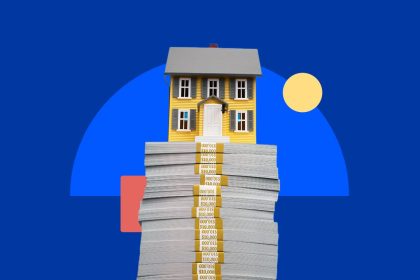Key takeaways
- To get a lower mortgage payment, you’ll likely need to focus on modifying the principal, interest, taxes or insurance you pay.
- You might choose to refinance or recast your mortgage to make the monthly mortgage payments more affordable.
- Addressing your property tax bill or eliminating PMI are other effective ways to get a break on your monthly housing costs.
Your mortgage payment is probably your biggest expense every month. But is it possible to make it smaller, and thus free up funds to meet other financial goals? There are ways to lower your mortgage payments, but they may not all be right for your situation. Here’s what to know so you can make the best decision for you.
How can I lower my mortgage payment?
Mortgage payments consist of four parts, often abbreviated to the acronym PITI: principal, interest, taxes (property) and insurance (homeowners and/or private mortgage insurance). Lowering your payments means addressing one or more of these elements. Options to reduce mortgage payments include:
- Refinance to lower your interest rate
- Recast your mortgage
- Eliminate your mortgage insurance
- Modify your loan
- Lower your taxes
- Shop around for a lower homeowners insurance rate
- Apply for mortgage forbearance
1. Refinance to lower your interest rate
Refinancing involves replacing your current mortgage with a new one. In a basic rate-and-term refinance, your new loan offers a lower interest rate, a longer term or both.
Several factors influence whether you’ll want (or be able) to refinance, including:
- Current refinance interest rates: Fees and closing costs come with a refi, just as they did with your original loan, so consider whether rates are low enough to justify the switch. Looking for a drop of at least 1 percentage point is a good rule of thumb.
- How long you’ll be in your home: Do you plan to stay in your home long enough to recoup the refinance closing costs? Usually, that means a couple of years at least.
- Penalties for paying your loan off early: Many mortgages come with a prepayment penalty, especially if the mortgage originated less than three years ago. If it does, refinancing to lower your payment may not make sense.
- Age of your mortgage: Many lenders won’t allow refinances for loans that closed within four to five months. But if your loan is recent enough that its amortization schedule still includes interest-heavy payments, it may be worth refinancing.
If you don’t qualify for a lower rate, you can often buy one by purchasing mortgage discount points. A form of prepaid interest, each mortgage point is the equivalent of 1 percent of the principal amount and shaves 0.25 percent off the interest rate. This is also called “buying down the rate.”
Bear in mind that using mortgage points increases your upfront costs in refinancing. So that will extend the amount of time you need to stay in the house to reach the break-even point that makes the refinance worthwhile.
“Refinancing works great when you can trade a higher rate for a lower rate — but mortgage rates have to cooperate, which is making this difficult at present,” says Greg McBride, Bankrate’s chief financial analyst. “There are also costs to refinancing, whether you pay them out-of-pocket or roll them into the loan.”
2. Recast your mortgage
Another approach is to attempt what’s called mortgage recasting. With this option, you make a lump-sum payment toward the principal. Then, your lender recalculates your monthly payments based on that new balance (but on the same loan term). The reduced loan amount means smaller monthly payments and less total interest paid over the course of the loan.
-
To illustrate how this works, let’s say you have a $300,000, 30-year mortgage with a 6 percent interest rate. Your current monthly payment is $1,798 for principal and interest.
-
Once you make payments for three years, your balance is about $288,250. You receive an inheritance and choose to make a $75,000 payment to lower the principal balance.
-
The principal balance on your loan will drop to $213,250. Once it’s recast, you’ll get a lower monthly payment of $1,278, which is roughly $500 lower than your initial loan payment amount.
Before proceeding, however, make sure you understand the negative sides to this approach. “The two main drawbacks of recasting are the need to come up with a significant lump sum to be applied to the balance and a lender that will recast the loan,” says McBride. “Check with your loan servicer to see if this is possible before devoting extra cash toward the principal.”
In addition, most lenders charge a recasting fee — typically between $250 and $500. Make sure to do the math to ensure it’s the best decision for your overall financial situation.
3. Eliminate your mortgage insurance
If you are paying private mortgage insurance (PMI), look into whether you can eliminate that. PMI is assessed by most lenders on conventional loans when the down payment is less than 20 percent of the purchase price. It costs homeowners between 0.46 percent and 1.50 percent of the loan amount each month, depending on your credit score, according to 2024 data from the Urban Institute. However, you can request to have it removed once you have 20 percent equity in your home.
“If your home has appreciated to the point that your current mortgage balance is less than 80 percent of the market value, you can ask the loan servicer to eliminate your mortgage insurance,” says McBride. “You may need to pay for an appraisal, and there is often a two-year seasoning requirement — meaning the loan has to be at least that old — before you can have the PMI premium removed.”
Let’s say you owe $250,000 on your mortgage, and you’re paying 0.5 percent PMI. That comes to $1,250 annually, or about $104 per month. So, eliminating your PMI payment would save you more than $100 per month.
4. Modify your loan
If you’re in financial distress, the government offers loan modification programs aimed at helping with financial hardships. A modification typically changes the loan’s rate or term (or both) to make monthly payments more affordable. It’s similar to refinancing, only with the same loan instead of a new one.
For example, you could extend a 30-year mortgage into a 40-year loan — then your payments will be lower, since they’ll be spread out over another decade. But bear in mind you’ll end up paying more in interest this way. “Yes, it will reduce your monthly payments, but you’ll have many more months of payments to make, so the savings is a bit of an illusion,” says McBride.
Not every lender will allow loan modifications, and there are stringent eligibility rules. And even if you get it, the difference may be too small to justify the eventual higher total cost of the loan due to paying interest for a longer period.
5. Lower your taxes
Other methods that can reduce payments don’t have to do with the mortgage loan itself. For example, you might try to lower the property tax amount that typically takes up a chunk of your monthly mortgage payment. Tax assessments are sometimes too high following real estate market corrections or local rezonings, for instance. If you think that could be the case for your house, consider appealing your property’s value to the relevant state or local decision-makers. Be aware of deadlines for filing an appeal if you go this route.
If the home is your legal primary residence, you could also try applying for a homestead tax exemption. Rules vary by state, but if you qualify, an exemption can reduce your tax bill by sheltering an eligible portion of your home’s assessed value from taxes.
6. Look for a lower homeowners insurance rate
When was the last time you shopped around for homeowners insurance? Even if you haven’t had any issues with your current provider, better rates may be available elsewhere.
Compare quotes from several reputable providers, and be sure to inquire about any rate discounts that may be available to you. Also, review the rate quotes to ensure the coverages included are comparable to your current policy, and ask about other ways to curb costs, like increasing your deductible.
7. Apply for mortgage forbearance
If all else fails and you’re in dire straits, you can talk to your lender about potentially putting your payments on hold for a while. Mortgage forbearance can offer temporary relief by lowering or pausing your payments for a short period. You’ll also avoid adverse credit reporting and foreclosure, and gain time to get your finances back in order.
Be mindful that the lender will likely require you to prove you’re experiencing financial hardship before approving you for forbearance. And it’s only a temporary reprieve. The payments you miss (including interest) must be paid eventually, in a lump sum or over time with a repayment plan. If you choose the latter, your monthly payment could increase significantly.
FAQs
Additional reporting by Lauren Dietlin and Allison Martin
Why we ask for feedback
Your feedback helps us improve our content and services. It takes less than a minute to
complete.
Your responses are anonymous and will only be used for improving our website.
Help us improve our content
Read the full article here
















